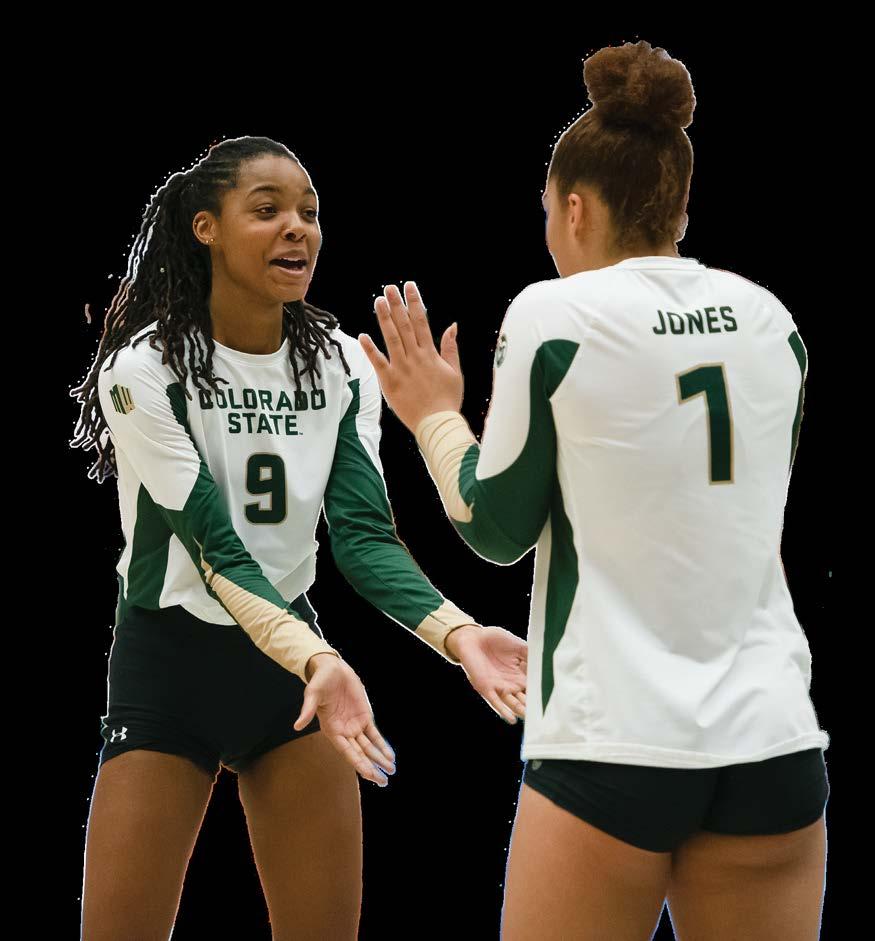
7 minute read
OPINION: Blouch: Polyamory is effective if you communicate properly
COLLEGIAN COLUMNISTS
Polyamory is effective if you communicate properly
Three people hold hands Sept. 11. The union between the three sets of hands represents polyamory. PHOTO ILLUSTRATION BY CAT BLOUCH THE COLLEGIAN
By Cat Blouch
@blouchcat Editor’s Note: All opinion section content reflects the views of the individual author only and does not represent a stance taken by The Collegian or its editorial board.
In 2022, who can really define love?
As society rapidly changes and we move toward new structures of communication, new structures surrounding relationships are created. Research has become more prevalent within the fields of gender and sexuality, and we are beginning to understand relationship structures that are outside the “traditional” one.
One of these relationship structures is polyamory. According to Chapter 16, “The Monogamous Couple, Gender Hegemony and Polyamory,” in the book “Gender Reckonings” by Mimi Schippers, “The word ‘polyamory’ means multiple loves and refers to emotionally and sometimes sexually intimate relationships with more than one person. Though we don’t have numbers on the extent of polyamory, it is estimated that people in consensually nonmonogamous relationships number in the millions.”
Polyamory might be a buzzword in the mouths of young collegeaged individuals looking to explore themselves sexually, but that doesn’t mean it’s widely understood.
This brings up many of the common misunderstandings of polyamory: that it’s usually one person’s idea and the other person in the relationship is going along with it or that those in polyamorous or open relationships can’t be truly happy or fulfilled — or at least not to the extent they would be in monogamous relationships. These misconceptions simply are not true.
In fact, research suggests polyamory might provide solutions to the relationship structure that monogamy alone cannot. In the academic inquiry article “More Oxygen Please!: How Polyamorous Relationship Strategies Might Oxygenate Marriage,” authors Terri Conley and Amy Moors wrote, “We propose that people engaged in polyamory may be navigating their higher altitude needs in relationships more effectively than people in monogamous relationships.”
The paper argues that in polyamorous relationships, the individuals retain more of their autonomy due to a phenomenon in monogamous relationships wherein “as a couple progresses toward cohabitation both partners withdraw from their respective social networks.” On the contrary, polyamorous relationships offer individuals looser restrictions with their social network, which supports them to maintain their social network.
This notion was echoed by Luna Martinez in her TEDxCSU talk.
“When I was in middle school, it was one man, one woman, for a lifetime,” Martinez said. “In high school, I kept getting these confirmations of, ‘I am trying so hard to invest in ... one other person, and why am I not investing that in myself or investing that in my friends or other people in general?’ It’s such a formative time.”
Polyamory encourages people to restructure their entire schema of love and relationships. Within the notion of offering more in social capital, polyamory encourages participants to seek their needs in multiple people instead of putting that responsibility on one individual.
When author Sophie Johnson spoke of her experience as a polyamorous person with New York Magazine, she said, “At some point, we got this idea that there was such a thing as ‘the one,’ and this person had to satisfy every little minutia of need, which is so unrealistic. It’s just not possible.”
You may think that with multiple people in the equation, infidelity is bound to happen, but this isn’t the case. In a polyamorous relationship, it’s all about communication.
“Infidelity can still occur in polyamorous relationships, especially when a partner violates a relational agreement,” Conley and Moors state in “More Oxygen Please!” “For example, one agreement might be that sex should not occur with a new partner without prior permission from other partner(s). Conflict could emerge if one partner then had a fling without prior approval.”
You and your partner(s) set the rules in a polyamorous relationship. This reliance on healthy communication can be a benefit for many people. Martinez echoed this in her speech, saying, “When you know your preferences, you can ask for them upfront. When you ask for them upfront, you can give yourself grace to change your mind.”
While polyamory provides an alternative to monogamy that many find beneficial in practice, it isn’t for everyone. Maybe you’ve found success and romance in a monogamous relationship, and that’s great.
Regardless, core tenets of polyamory such as respect, trust and communication can still be applied to any relationship — even those that aren’t romantic.
Reach Cat Blouch at letters@ collegian.com.
COVER STORY
CSU volleyball: Taking a knee for a cause beyond the game

By Karsyn Lane
@karsynlane1
In a symbolic act of resistance to racism, one kneels instead of standing during the performance of the national anthem or at other appropriate moments. This movement originated when Colin Kaepernick, soon joined by thenSan Francisco 49ers teammate Eric Reid, kneeled during the playing of the national anthem before a football game in 2016. Since that time, leagues, professional teams and well-known athletes all around the country have taken
the initiative to kneel in support of a much larger message, including three volleyball players from Colorado State University. Kennedy Stanford, Malaya Jones and Naeemah Weathers first began taking a knee back in 2020 during the COVID-19 pandemic, mass civil rights movements and the death of George Floyd. Floyd’s murder solidified a new generation of players as protesters of police brutality and at the very least made professional sports leagues performative supporters. The history of athlete activism serves as a reminder that this movement has dramatic potential and the Rams recognized their actions deserve to be brought to light.
Taking a knee not only brings awareness to inequalities in this country but also quite a bit of controversy. Common misconceptions include kneeling often being portrayed as a sign of disrespect to the country and its troops, that it’s ineffective and that it causes even more division among people. Despite these misconceptions, taking a knee is a pro-rights movement that exercises the rights of the First Amendment, like freedom of speech.
“For us two (Stanford and Weathers), we both have parents who are former military,” Stanford said. “We understand it’s not a sign of disrespect; it is truly just a way to visually show people what we stand for and that we stand for equal rights. We want to respect the national anthem but also recognize that there is a lack of equity in this country, and that is something we want to see change.”
With Moby Arena’s capacity of nearly 9,000 fans, the Rams are aware of the size of their audience, which may include some people who don’t understand. However, the three expressed that Moby Arena has provided the perfect platform for Stanford, Jones and Weathers to spread awareness and receive only supportive responses.
“I think that it’s super important to be able to show that it’s not antione thing, it’s pro-another,” Weathers said. “It’s pro-equity; it’s pro-equal rights; ... it’s making sure people are educated and learn that we don’t just kneel just to kneel. We kneel to start conversations like this one so that people can become more well educated on racial inequalities and civil rights.”
Despite receiving a supportive response from the Colorado State community, the Rams still had to acknowledge the regression and alternate reactions when attending away games. The players noted that head coach Tom Hilbert discussed with them that not every state or arena the Rams attend will accept or recognize the deeper meaning behind the trio kneeling. Regardless, the trio plans to continue to kneel as long as necessary because of the unity and strength it brings them as young Black athletes.
“Why don’t I just put my hands behind my back or just stand and not take the pledge?” Jones asked. “For me personally, that is just not enough. ... I need to take a knee because that is what it represents. It represents Black power; it represents fighting for Black inequality in America. A lot of people are like, ‘Why do I need to do the most? Why do I need to put on a show? Why are you drawing attention to yourself?’ It’s absolutely not like that, and that needs to be crushed completely.”
All in all, the Rams stressed how it’s important to educate about, acknowledge and challenge the inequalities of racial injustices. Taking the effort to educate yourself and others about the causes of racial injustice and how it affects racialized communities in society is a crucial step in the fight against it. The first step to becoming an active ally is learning about opening up to difficult conversations.
“In sports, we kneel when someone is injured,” Stanford said. “It’s a sign of respect, truly, and if it’s us showing alternative respect during the national anthem, it shouldn’t be looked at as something bad.”
What these players do highlights the true unity and respect athletics is built upon. It’s taking a knee for a message much bigger than a game.
Reach Karsyn Lane at sports@ collegian.com.

KENNEDY STANFORD
CSU JUNIOR OUTSIDE HITTER
PHOTOS BY LUCY MORANTZ
THE COLLEGIAN





